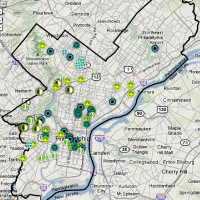Adaptation, Mitigation, City Greening and Water Cleaning – Philadelphia Water Tackles Climate Change

Top Left: Solar panels at our Southeast Water Pollution Control Plant; Bottom Left: Part of our Sewage Geothermal Installation, located at the Southeast Water Pollution Control Plant; Right: Trees and plants at hundreds of sites citywide represent a green infrastructure network well-suited for coming climate change impacts.
Philadelphia Water was recently nominated as a “Climate Hero” for the first-ever SustainPHL, a citywide sustainability celebration hosted by the great people behind Green Philly Blog. The event will take place on August 18 at the WHYY studios on 6th Street, across from Independence Hall.
By their definition, Climate Hero nominees “…advocate to bring climate change as a central part of our conversation or take action to fight climate change.”
So what puts us in this category along with Swarthmore College and #ClimateDisrupted? How can a water department like Philadelphia Water be a “Climate Hero”?
A better question might be: how could we not get involved in climate change?
By the end of the century, Philadelphia will be warmer and wetter. All climate change projections indicate that we will experience sea level rise, higher temperatures, and more rain and extreme storms. These climate impacts, if not proactively addressed, will negatively impact the functioning and reliability of our water systems and make the challenges that we currently face worse.
That’s why we are already working toward solutions and building resiliency. We have programs dedicated to climate change mitigation and adaptation, and we’re increasing our resilience to a wetter climate through our Green City, Clean Waters program.
Mitigation
Our energy program is playing a key role in climate mitigation, seeking to reduce greenhouse gas emissions by improving energy efficiency, resource recovery and renewable energy production. Our energy team consists of scientists and engineers who are experts at turning what would otherwise be considered waste into a resource. Since 1990, Philadelphia Water has reduced its greenhouse gas emissions by 35 percent, and today, 10 percent of our energy needs are met by renewables. Learn more about our resource recovery and energy projects here.
Adaptation
The Climate Change Adaptation Program (CCAP) at Philadelphia Water was started in 2014 to help us better understand the impacts climate change will have on our water systems and reduce the risks and associated expenses by identifying and implementing adaptation strategies. The CCAP stays up-to-date on the latest climate change science and works closely with other city agencies, like the Philadelphia Office of Sustainability, to leverage resources and ensure that citywide adaptation efforts are coordinated. To learn more about the CCAP, check out our blog post on climate change and the Paris Climate Talks from December 2015.
Resilience
Prior to the start of the CCAP, Philadelphia Water was already in the process of implementing Green City, Clean Waters. Formally adopted in 2011, Green City, Clean Waters is Philadelphia's plan to reduce stormwater pollution currently entering our Combined Sewer System through the use of green infrastructure. It also happens to be one our best tools for addressing the impacts of climate change.
Green City, Clean Waters aims to turn Philadelphia into a greener environment filled with vegetation that can absorb stormwater runoff. Green infrastructure systems help to reduce localized flooding, recharge groundwater reserves and naturally filter and clean stormwater runoff, reducing the energy use at our treatment plants.
Green City, Clean Waters also helps us mitigate climate change—trees and plants in our green infrastructure systems absorb carbon dioxide, one of Earth’s primary greenhouse gases, improving air quality. The plants used in these systems may even help reduce the urban heat island effect.
The wide distribution of thousands of green infrastructure sites across the city makes Green City, Clean Waters flexible and adaptable—a crucial quality given the uncertain future climate change presents for Philadelphia. Today, Philadelphia has hundreds of new green infrastructure sites representing thousands of green tools like rain gardens, tree trenches and stormwater tree planters.
By using a combination of traditional infrastructure improvements and green infrastructure investments, we create a far more adaptable network of tools that will allow us to better respond to a future where problematic storms and climate extremes may well be more frequent.
The Long View
By 2036, the last year of the 25-year Green City, Clean Waters plan, Philadelphia will have infused our urban landscape with nearly 10,000 greened acres, making our air cleaner, our streets cooler, and our waterways healthier thanks to the elimination of about 9 billion gallons of polluted water annually.
The task of addressing changing climate is, to be sure, formidable, but what hero ever had it easy? The reality of climate change is an inescapable one, and that’s why Philadelphia Water is serious about preparing for a warmer, wetter future.
We hope you can join us Aug. 18 to celebrate all of the amazing visionaries and heroes that help make our city a more sustainable place to live. You can learn more about the event and purchase tickets here.





